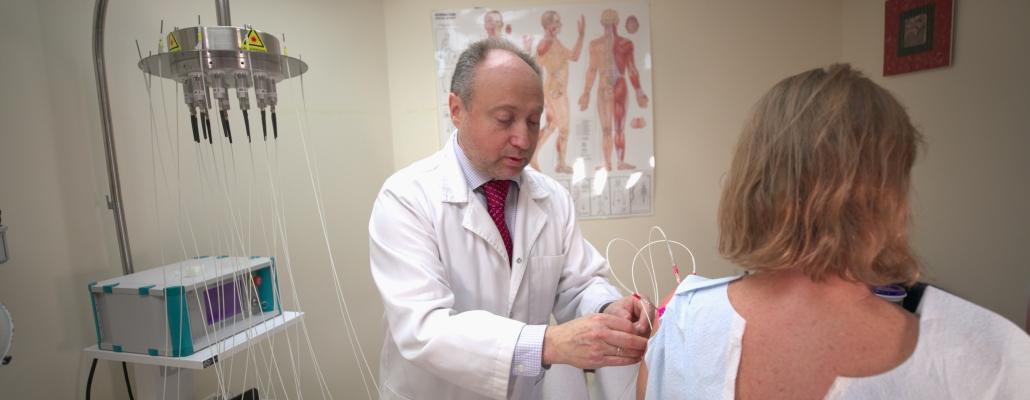Laser Acupuncture vs Traditional: Choosing the Right Treatment for Sports Injuries
Sports injuries happen to most athletes. Practitioners often use acupuncture as an alternative therapy for treating injuries related to sports. There are two basic forms: laser and traditional needle-based acupuncture. Acupuncturists stimulate particular spots on the body by using tiny needles or lasers inserted through the skin. It has been used as a helpful, conservative, noninvasive treatment for managing sports injuries such as lateral meniscus rupture, femoral acetabular impingement, ganglion cysts, and sports hernia, easing acute discomfort and healing from dysfunction.
The American Pain Society, the National Institutes of Health, and the World Health Organization endorse this therapy due to its effectiveness and affordability in treating pain, emesis, respiratory illnesses, and central nervous system disorders.
Examining the efficacy of Traditional Acupuncture in Sport injuries
In traditional acupuncture, the body is inserted with needles to treat or prevent a medical condition. The treatments have shown positive results for athletes in most sports through reduced pain, delayed-onset muscle soreness, peak oxygen levels, explosive force production, and joint mobility. Traditional acupuncture might be a more appropriate method of treatment for deep musculoskeletal injuries, where needle penetration is necessary to reach the injured area.
Cultural factors impact the acceptance of traditional methods, with Western and East Asian cultures expressing different opinions regarding the practice's justification and mode of operation. Although Western concepts have recently been added, East Asian acupuncturists usually base their treatments on qi and meridian theories. It is possible to leave the needles in place without stimulating them or to stimulate them by rotating the needles, applying heat (moxibustion), or through electricity application. This nonpharmaceutical therapy can induce pain management, particularly in the musculoskeletal system.
Laser Acupuncture in sport injuries
Laser treatment involves applying low-intensity radiation to acupuncture points instead of needles. The process is safe and doesn't hurt. It is appropriate for those who are afraid of or sensitive to needles, and the dosage may be electronically adjusted. Treating requires 5 to 20 seconds per point, substantially reducing treatment time compared to using a needle. The therapy heats the tissue by directing light energy into particular bodily parts, lessening pain and inflammation. A machine and a handheld device placed against the treatment area administer laser therapy. Deep into the tissue, the handheld device's laser energy penetrates your skin as it passes across it. The light energy targets and decreases inflammation, reducing pain sensations.
Laser therapy is well-suited for treating pain conditions such as sciatica, sports injuries, shoulder and knee pain, neck and back pain. Because it tackles pain at the cellular level, it may help reduce pain and swelling from acute wounds like strains and sprains and chronic conditions like disc problems.
This method might be more beneficial for hard-to-reach internal sports injuries. Acupuncture points undergo a photochemical reaction in the cells, known as photobiomodulation, caused by the laser.
Because it has an optical power of about 40 mW and produces effects comparable to metal needles, it may be a desirable choice for treating chronic pain from sports injuries.
Choosing the right Therapy for sports injuries
To help athletes heal and rehabilitate, needles inserted into specific acupuncture points can help lower pain, reduce inflammation, and increase range of motion. The traditional needle-based method is still a well-researched and proven treatment for various sports-related wounds, even though laser offers certain special benefits. The unique benefits of laser acupuncture make it an appealing alternative for treating many sports injuries, especially those requiring immediate pain relief and faster tissue healing.
The patient's needs, the practitioner's experience, and the clinic where the treatment is given are often the deciding factors between the two methods of treatment. One clear distinction between the two techniques is that the laser allows for point stimulation without causing harm to the skin.
If you are considering traditional or laser therapy, a professional acupuncturist, such as Dr. Vadim Dekhtyar, DACM in Glenview, IL, can guide you to the best course of treatment. Please do not hesitate to schedule a consultation.
Conclusion
Since none of the treatment requires the use of drugs, you won't need to depend on tablets that can have adverse health effects. You can avoid stitches, hospital stays, and scars. Despite the numerous studies that support their efficacy, the effectiveness of both traditional and laser acupuncture is still debatable. More research is still required to determine acupuncture's effectiveness for sports injuries. More studies should be supported so that it can be used safely in sports medicine.
